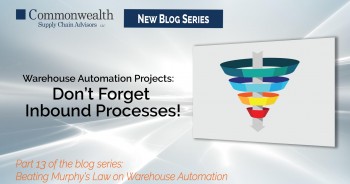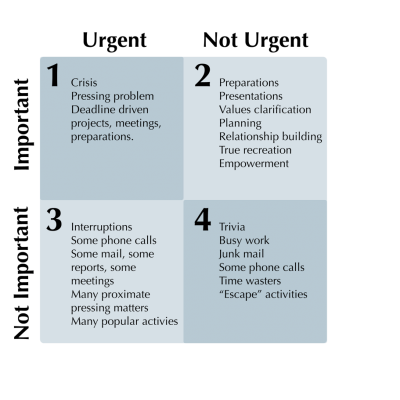Commonwealth Supply Chain Advisors recently published a ground-breaking white-paper titled, “Beating Murphy’s Law in Warehouse Automation Projects.” The full paper examines a number of the reasons why automation projects fail to meet expectations, and what companies can do to beat Murphy’s Law. This blog is thirteenth in an ongoing series on “Beating Murphy’s Law in Warehouse Automation Projects.”
 On warehouse automation projects, the outbound processes of picking, packing, and shipping often receive a disproportionate degree of attention during the design process, to the exclusion of inbound processes like receiving, put-away, and bin replenishment. Companies often reason that, because failure to ship product can put them out of business quickly, all resources must be focused on this area, and that somehow the replenishment process will “figure itself out.”
On warehouse automation projects, the outbound processes of picking, packing, and shipping often receive a disproportionate degree of attention during the design process, to the exclusion of inbound processes like receiving, put-away, and bin replenishment. Companies often reason that, because failure to ship product can put them out of business quickly, all resources must be focused on this area, and that somehow the replenishment process will “figure itself out.”
While it is true that problems with outbound processes can negatively impact the operation in immediate and direct ways (orders don’t ship), inbound problems may be slower to manifest themselves, but every bit as serious to the operation. Many material handling systems appear to go live successfully at first, with just “a few minor problems” putting away product and replenishing the forward pick areas. However, as these “minor problems” build up, they can eventually cripple an operation over time as each day, more and more pickers arrive at bins that do not have enough product to fill their orders. More and more labor must be dedicated to getting product in the right pick faces, or inefficiently performing picks from reserve locations. Often, when trying to quickly stock bins to get product out the door, workers may take short-cuts and make product moves without taking the time to record them in the WMS system. This creates another insidious problem as inventory accuracy begins to drop, making the WMS incrementally less able to effectively trigger replenishment tasks. The impact of inbound flow problems is less immediate, but just as consequential as outbound problems.

|
This inattention to inbound processes is a classic case of failing to focus on areas of the design that are “important, but not urgent,” known as the “Quadrant 2” tasks, a term coined by author Stephen Covey in The Seven Habits of Highly Effective People. If “important, but not urgent” areas are ignored long enough, they become critically urgent and can potentially sink a project.
The remedy to this situation is to insist on rigorous design and discussion around the receiving, put-away, replenishment, and slotting processes at all design meetings. The rules for system-directed put-away must be thoroughly defined:
- How will the WMS or WCS know if newly arrived product will be able to fit in the desired bin location?
- Will bins that already contain product be “topped-off”, or should new product always be put in empty bins only?
- If newly-arrived product is put-away in overstock locations as a rule, what should happen if the forward pick location is empty? Should new products be put there first?
- How will the WMS system manage these rules and execute this strategy?
Attention should also be given to bin replenishment:
- What will be the replenishment triggers?
- Will minimum and maximum stocking levels be defined for each product in each forward pick bin?
- How precise will these rules be?
- What happens if a SKU is re-slotted in a different forward-pick storage medium?
- How will the min/max quantities be calculated?
- What will be the specific trigger for min/max bin replenishment?
- Will the trigger occur as soon as product is allocated from a bin that will deplete it below the minimum level?
- Can bins be proactively replenished prior to product being allocated and waved to orders?
- Will pickers only be sent to bins when it is known that there is sufficient product to fill the demand to avoid a random, first come/first served allocation in short stock situations?
- What will happen if a replenishment takes place before the bin is depleted and the newly arrived product will not fit in the bin? Where will the product be placed?
- Can a certain percentage of bins be intentionally left empty to accommodate these situations?
- How much labor will be required to replenish bins each day?
- How much additional labor will be required to get through the “Murphy’s Curve” period of reduced productivity?
- Has this labor been obtained and trained?
- How will replenishment tasks be measured and managed-to, each day?
Slotting rules and data integrity are also key topics to address:
- What rules will be used to slot the forward pick locations?
- Will slotting be based upon sales velocity, SKU affinity, segregation, family groupings, or other criteria?
- What system will manage these rules and suggest the optimal bin location for each SKU?
- How will this information be relayed to the WMS or WCS during put-away and replenishment tasks?
- What will be done to remediate data errors as they are encountered?
- If a replenishment worker is unable to fit all the product in the bin as expected, is there a defined resolution path where the situation can be investigated, and can corrections be made to master data expeditiously?
By giving thorough attention to these and other issues during the Design Engineering period, companies can help ensure a harmonious flow of materials in the distribution center in both inbound and outbound directions.
To read Commonwealth’s complete white-paper titled, Beating Murphy’s Law in Warehouse Automation Projects, click here.
